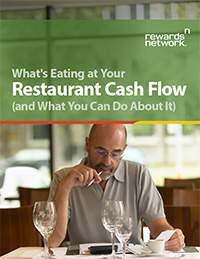With the economy in doubt, many restaurant owners are starting to worry and ask the question:
Is my restaurant cash flow going to take a hit?
We take a step-by-step look at the economic challenges your restaurant profit is likely facing in the coming months, including:
- Expected costs like food prices, restaurant marketing, and breakage
- Variable expenses like maintenance, server error, and waste
… and ways to generate more restaurant profit to your bottom line, as well.
Download this free eBook today to identify what you can do to minimize these drains on your restaurant cash flow, and increase your restaurant sales today.
Excerpt from Chapter 3:
Figuring out new ways to increase your restaurant sales is a big part of what it means to manage your cash flow and turn around negative results. But identifying profitable ideas that organically build on your existing brand isn’t always easy.
You never want to expand with new opportunities at the expense of your core business — or the relationship with your solid customer base. Finding a way to improve your cash flow, not simply shift your existing business to a larger pool temporarily, respects your success to date. And it will help you maintain trust with your existing diners and staff, too.
With that in mind, we have assembled seven ways to expand your restaurant profits — and thoughts on how to implement without undoing any of your hard work.
One of the easiest ways to introduce something new to your restaurant’s routine is the LTO — the limited time offer. Controlled in its scope, a successful LTO can be anything from a single dish to a full, additional menu, so long as it feels unique and fleeting. It’s not enough to just conceive of a new dish.
That FOMO (“fear of missing out”) sense of urgency your customer feels must be developed through advertising, whether external (signage, ads, window posters) or internal (upselling by staff, table tents, menu inserts). Otherwise, your LTO is just another menu item that could easily be overlooked.
Your LTO can be a discount opportunity, but it doesn’t have to be. Simply offering something that incorporates a new seasonal ingredient or combines two things your customers haven’t seen on your menu before can generate enough interest for success. Just be careful that your pricing covers any additional expense generated from going outside your usual repertoire, but still works for the market you service.
And who knows? If your LTO is profitable, it may earn a rotating place on your menu. If it isn’t, your commitment is as limited as the offer itself. But no matter what, stick to your guns with an end date. It’s part of what makes the opportunity special.
Adding a weekend brunch (or other special occasion) buffet can seem like a profit loser at first glance. All-you-can-eat is a frightening prospect when planning out prices and cost, not to mention ensuring that your prevailing brand doesn’t get diminished. That said, there’s a wide range of restaurants that host buffet-style serving, from casual to fine dining, and there’s a reason for it — buffets are profitable.
Your typical buffet offering works best when you keep a few key tactics in mind. Pre-cut sizes for proteins encourages smaller portions of your most expensive items. Customers will often self-police the amount of any one item they take — if for no other reason than to leave room for sampling as many different items as possible.
For the guest, buffets are an opportunity to experience everything you as a restaurant have to offer. For you, it’s an opportunity to offset a few high-cost food items with many more at a low cost (potatoes, breads, pasta) at a premium price for the experience. And even if your buffet price is in line with your normal menu, the opportunity to upsell high cost liquor in drinks not already included in the price, like a mimosa or Bloody Mary, can take your Sunday brunch from average to exceptional in sales.
Another avenue for increasing restaurant profit apart from your normal restaurant experience is building out a catering menu and service. The opportunity to build your reputation through word of mouth and positive experiences both in and out of your restaurant is tempting. So too is the ability to prepare food with advance notice on a set budget and for a predetermined number of guests. But every profit-generating opportunity also comes with a price.
Catering can be an intense burden on your existing staff and, as a manager, it falls on you to keep these two tracks of your business from disrupting each other. It also requires an investment in additional equipment, reliable transportation, and — quite possibly the most important part — a salesperson. Having a single person committed to each event, from initial appointment to contract review to execution, is critical.
But despite the upfront financial costs, adding catering to your restaurant’s repertoire can lead to better exposure for your restaurant and an additional steady stream of income, especially around holidays where you may see fall-off in your dining room service.
